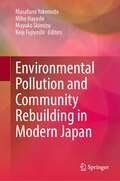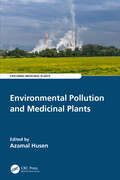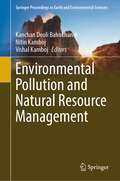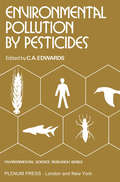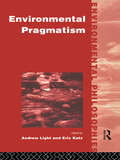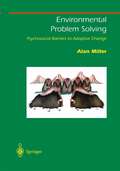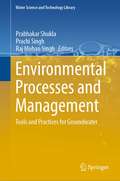- Table View
- List View
Environmental Pollution: Select Proceedings of ICWEES-2016 (Water Science and Technology Library #77)
by Vijay P Singh Shalini Yadav Ram Narayan YadavaThis book comprises select proceedings of the International Conference on Water, Environment, Energy and Society. The book is divided into five parts. The first part deals with some aspects of environmental pollution such as socio-economic environment assessment for sustainable development, environmental issues due to fire in coal Mines and its impact and suggestions for implementing precautionary and control measures, redevelopment of urban slum dwellings: issues & challenges, air and noise pollution in mega cities, importance of indoor environmental quality in green buildings. Part II discusses pollution indicators such as assessment and prediction of environmental noise, fuzzy logic based performance evaluation, fish biodiversity and its periodic reduction, effects of anthropogenic activities on fresh water ecosystems, and monitoring of air pollution. Part III focuses on generation of pollution namely biomedical waste generation and management, heavy metal leaching, etc. Water quality assessment is described in Part IV. The Part V presents water quality modeling. The book will be of interest to researchers and practitioners in the field of water resources, hydrology, environmental resources, agricultural engineering, watershed management, earth sciences, as well as those engaged in natural resources planning and management. Graduate students and those wishing to conduct further research in water and environment and their development and management will also find the book to be of value.
Environmental Pollution and Community Rebuilding in Modern Japan
by Masafumi Yokemoto Miho Hayashi Mayuko Shimizu Keiji FujiyoshiThis book describes how modern industry affected people in Japan and their communities by polluting their living environment with toxic emissions. It also shows how the populace endeavored not only to restore their once-clean environment but also to rebuild communities that had been damaged by pollution and its accompanying effects. Environmental pollution is usually referred to in Japan as kogai, public damage, meaning that such pollution not only harms the physical environment—air, water, soil, and the human body—but also destroys the social and personal relationships in the polluted area. Those people who took action recognized that industrial and economic development had been given the highest national priority even at the cost of their health and welfare. In this sense, anti-kogai movements led them to alternative community development and to rethinking what kind of environment and community they wanted. This book also explores the efforts driven by residents in several parts of Japan after the middle of the twentieth century and the endeavors of museums and archives as a memorial to those who suffered from the pollution and for the prospect of a better society with a good environment.
Environmental Pollution and Medicinal Plants (Exploring Medicinal Plants)
by Azamal HusenEnvironmental Pollution and Medicinal Plants presents information on the impact of environmental pollution on the performance of medicinal plants at various levels including damage detection, adaptation, tolerance, and physiological and molecular responses.This title draws attention not only to seeking new bioactive compounds for herbal drug preparation, but also on ensuring high standards of quality through evaluation of the chemical purity of medicinal plants growing under polluted conditions. It discusses the latest trends and responses of medicinal plants, indicating their tolerance and adaptation to environmental pollution. This book also focuses on secondary metabolites, phytochemicals, and bioactive compounds associated with medicinal plants growing in contaminated conditions.This book will be indispensable for students and professionals working in the field of environmental pollution, medicinal plants, and herbal medicine, as well as for plant biologists, economic botanists, molecular biologists, and biotechnologists.. KEY FEATURES Explains the global trend of environmental pollution and its impact on medicinal herbs with the help of clear text and attractive illustrations. Provides a comprehensive overview of medicinal plants and their interaction with environmental pollution in terms of damage detection, repair, acclimation, tolerance, adaptation, and physiological responses. Discusses the production of secondary metabolites, phytochemicals, and bioactive compounds (used for herbal drug preparation) in medicinal plants growing in the vicinity of contamination and pollution load. Highlights opportunities and future challenges in "omics" studies on medicinal plants.
Environmental Pollution and Medicinal Plants (Exploring Medicinal Plants)
by Azamal HusenEnvironmental Pollution and Medicinal Plants presents information on the impact of environmental pollution on the performance of medicinal plants at various levels including damage detection, adaptation, tolerance, and physiological and molecular responses.This title draws attention not only to seeking new bioactive compounds for herbal drug preparation, but also on ensuring high standards of quality through evaluation of the chemical purity of medicinal plants growing under polluted conditions. It discusses the latest trends and responses of medicinal plants, indicating their tolerance and adaptation to environmental pollution. This book also focuses on secondary metabolites, phytochemicals, and bioactive compounds associated with medicinal plants growing in contaminated conditions.This book will be indispensable for students and professionals working in the field of environmental pollution, medicinal plants, and herbal medicine, as well as for plant biologists, economic botanists, molecular biologists, and biotechnologists.. KEY FEATURES Explains the global trend of environmental pollution and its impact on medicinal herbs with the help of clear text and attractive illustrations. Provides a comprehensive overview of medicinal plants and their interaction with environmental pollution in terms of damage detection, repair, acclimation, tolerance, adaptation, and physiological responses. Discusses the production of secondary metabolites, phytochemicals, and bioactive compounds (used for herbal drug preparation) in medicinal plants growing in the vicinity of contamination and pollution load. Highlights opportunities and future challenges in "omics" studies on medicinal plants.
Environmental Pollution and Natural Resource Management (Springer Proceedings in Earth and Environmental Sciences)
by Kanchan Deoli Bahukhandi Nitin Kamboj Vishal KambojThis book presents conference articles related to environmental pollution and natural resource management, and environmentally friendly technologies that lead to sustainable development presented in the Conference "Sustainable Management of Environment & Natural Resource Through Innovation in Science and Technology". The book highlights the latest development and innovation in environmental science, technology, and interdisciplinary research to improve the environment and health safety. It includes innovations and improvisations in the broad area of science and technology, natural resource, and environment management. It deliberates on the current burning issues of environment protection management and sustainable development, environmental pollution, global warming, and climate change.The development strategies must therefore be shaped by the following components:The satisfaction of basic human requirementsThe eradication of povertySelf-reliant and participatory developmentEnvironmental consciousnessTechnology has to play a critical role in the process of changing industrial society. But innovation has to be embedded in social and organizational innovation. This book provides a wide range of research articles in the area of science and technology, sustainability, natural resource management, ecology and its environmental fields, geosciences and geology, atmospheric sciences, sustainability, climate change, and extreme weather, global warming, and environmental change, the effect of climate change on the ecosystem, environment, and pollution.
Environmental Pollution and Plant Responses
by Shashi Bhushan Agrawal Madhoolika AgrawalComprehensive and global in scope, Environmental Pollution and Plant Responses provides an analysis of the research on the factors contributing to the deteriorating environmental quality and its effect on plant performance. The issues include: environmental pollution and global climate change, response patterns of plants at different levels, mechanisms of interaction, tolerance strategies and future research prospects. The author evaluates trends and gives management strategies for abating the problem. This volume highlights the complexities of environmental problems and the affect of pollution on every level of the ecosystem.
Environmental Pollution and Plant Responses
by Manfred Tevini Shashi Bhushan AgrawalComprehensive and global in scope, Environmental Pollution and Plant Responses provides an analysis of the research on the factors contributing to the deteriorating environmental quality and its effect on plant performance. The issues include: environmental pollution and global climate change, response patterns of plants at different levels, mechanisms of interaction, tolerance strategies and future research prospects. The author evaluates trends and gives management strategies for abating the problem. This volume highlights the complexities of environmental problems and the affect of pollution on every level of the ecosystem.
Environmental Pollution and Remediation (Environmental and Microbial Biotechnology)
by Ram PrasadThis book presents state-of-the-art environmental remediation processes. Environmental protection and management is a global concern, especially in the context of industrial regions. Over the years, several conventional, engineering-based physicochemical decontamination methods have used in the remediation of polluted sites. However, these methods are expensive and have limited efficiency. Drawing on research and examples from around the world, this book offers a comprehensive review of and insights into green technologies and sustainable remediation alternatives. It discusses the emerging importance of nanotechnology, chemo and biosensors, indicator species, microbe-based remediation of organic compounds, and ex-situ remediation methods. Addressing the growing global need for a holistic overview of the environmental remediation of polluted sites, it will appeal to teachers, researchers, scientists, capacity builders, and policymakers. It also serves as additional reading material for undergraduate and graduate students of biotechnology and environmental sciences.
Environmental Pollution, Biodiversity, and Sustainable Development: Issues and Remediation
by Hasnain Nangyal Muhammad Saleem KhanEnvironmental Pollution, Biodiversity, and Sustainable Development: Issues and Remediation provides an extensive summary of biodiversity. It is the result of the assistance of environmentalists, researchers, policy experts, and academicians from across the globe sharing their research and knowledge on biodiversity and ways to mitigate the threat from climate change, over-utilization of natural resources, pollution, and more. The volume considers that biodiversity encompasses a wide range of biological processes, ranging from genetic diversity, species, populations, communities and ecosystems to landscapes and regions. This book, written by a panel of international experts in biodiversity, conservation biology, and evolution from different countries, including Iran, Pakistan, India, Bangladesh, Tajikistan, Russia, and others, highlights the human impact on biodiversity hotspots on a global scale. The volume provides an abundance of valuable research for faculty, students, and researchers in environmental sciences, government agencies, and many others.
Environmental Pollution, Biodiversity, and Sustainable Development: Issues and Remediation
by Hasnain Nangyal Muhammad Saleem KhanEnvironmental Pollution, Biodiversity, and Sustainable Development: Issues and Remediation provides an extensive summary of biodiversity. It is the result of the assistance of environmentalists, researchers, policy experts, and academicians from across the globe sharing their research and knowledge on biodiversity and ways to mitigate the threat from climate change, over-utilization of natural resources, pollution, and more. The volume considers that biodiversity encompasses a wide range of biological processes, ranging from genetic diversity, species, populations, communities and ecosystems to landscapes and regions. This book, written by a panel of international experts in biodiversity, conservation biology, and evolution from different countries, including Iran, Pakistan, India, Bangladesh, Tajikistan, Russia, and others, highlights the human impact on biodiversity hotspots on a global scale. The volume provides an abundance of valuable research for faculty, students, and researchers in environmental sciences, government agencies, and many others.
Environmental Pollution by Pesticides (Environmental Science Research #3)
by C. EdwardsThe persistent organic pesticides have saved millions of lives by controlling human disease vectors and by greatly increasing the yields of agricultural crops. However, in recent years man has become ever more conscious of the way in which his environment is becoming increasingly polluted by chemicals that may harm plants, animals or even himself. Amongst these chemicals the organochlorine insecticides have been well to the fore as a major cause of anxiety to ecologists, not only because they persist so long, but also because of the readiness with which they are taken up into the bodies of living organisms, especially the fatty tissues of both animals and humans. The extent and seriousness of the potential hazards due to these chemicals still remains to be fully defined. Our information on the occur rence of residues in the various parts of the environment is very uneven and localized. For instance, whereas we have a great deal of data on residues in North America, we know virtually nothing about the extent of pesticide contamination in Africa, South America and much of Asia, although large amounts of organochlorine insecticides have been used in these areas.
Environmental Pollution of Paddy Soils (Soil Biology #53)
by Muhammad Zaffar Hashmi Ajit VarmaThe paddy field is a unique agro-ecosystem and provides services such as food, nutrient recycling and diverse habitats. However, chemical contamination of paddy soils has degraded the quality of this important ecosystem. This book provides an overview of our current understanding of paddy soil pollution, addressing topics such as the major types of pollutants in contaminated paddy soil ecosystems; factors affecting the fate of pollutants in paddy soil; biomonitoring approaches to assess the contaminated paddy soil; the impact of chemicals on soil microbial diversity; and climate change. It also covers arsenic and heavy metal pollution of paddy soils and their impact on rice quality. Further, new emerging contaminants such as antibiotics and antibiotics resistance genes (ARGs) in paddy soil and their impact on environmental health are also discussed. The last chapters focus on the bioremediation approaches for the management of paddy soils.
Environmental Pollution of the Pearl River Estuary, China: Status and Impact of Contaminants in a Rapidly Developing Region (Estuaries of the World)
by Wen-Xiong Wang Philip S. RainbowThe Pearl River Estuary (PRE) is the Western name for a very large estuary in southern China that is currently home to an industrial metropolis of staggering size, and one that is rapidly evolving. The Chinese name for the Pearl River is Zhujiang. Guangzhou lies at the head of the estuary, and Macau and Hong Kong are on the western and eastern sides, respectively, of the wide opening of the estuary to the South China Sea. The new cities of Zhuhai and Shenzhen lie immediately north of Macau and Hong Kong, respectively. The recent establishment of the Greater Bay Area (GBA), which covers the majority of the Pearl River Delta area, with a total population of over 70 million, will certainly put the PRE under strict environmental scrutiny. The PRE system itself will provide a model system for environmental scientists owing to its major anthropogenic perturbation and influences, as well as the highly dynamic nature of the estuary. This book addresses the major environmental concerns regarding this estuary, contaminants and other pollutants, e.g. toxic metals, organic contaminants and emerging compounds. Questions addressed here include: What are the sources of the contaminants? What have the environmental consequences of these contaminants been for the estuary? What will the future bring? The research presented here on the Pearl River Estuary offers a wealth of insights for other major contaminated estuaries around the world.
Environmental Populism: The Politics of Survival in the Anthropocene
by Mark BeesonThis book evaluates climate change and populism, two ideas that do not generally go together. The author argues that perhaps they should if policymakers are to be galvanized into action before it is too late. Although populism is usually associated with right-wing authoritarianism, there is growing interest in more progressive forms of populist politics. Across the world, young people in particular are mobilizing to demand change from an older generation that appears to be incapable of action or is hostage to powerful vested interests and outdated ideas. In this book, the author explains why populist forms of political action may yet provide the key to effective policies, which are often discussed but less frequently implemented. Accessible and trenchantly argued, this book presents a primer for the politics of survival.
Environmental Pragmatism
by Eric Katz Andrew LightEnvironmental pragmatism is a new strategy in environmental thought. It argues that theoretical debates are hindering the ability of the environmental movement to forge agreement on basic policy imperatives. This new direction in environmental thought moves beyond theory, advocating a serious inquiry into the merits of moral pluralism. Environmental pragmatism, as a coherent philosophical position, connects the methodology of classical American pragmatic thought to the explanation, solution and discussion of real issues. This concise, well-focused collection is the first comprehensive presentation of environmental pragmatism as a new philosophical approach to environmental thought and policy.
Environmental Pragmatism
by Eric Katz Andrew LightEnvironmental pragmatism is a new strategy in environmental thought. It argues that theoretical debates are hindering the ability of the environmental movement to forge agreement on basic policy imperatives. This new direction in environmental thought moves beyond theory, advocating a serious inquiry into the merits of moral pluralism. Environmental pragmatism, as a coherent philosophical position, connects the methodology of classical American pragmatic thought to the explanation, solution and discussion of real issues. This concise, well-focused collection is the first comprehensive presentation of environmental pragmatism as a new philosophical approach to environmental thought and policy.
Environmental Problem Solving: Psychosocial Barriers to Adaptive Change (Springer Series on Environmental Management)
by Alan MillerHuman influences create both environmental problems and barriers to effective policy aimed at addressing those problems. In effect, environmental managers manage people as much as they manage the environment. Therefore, they must gain an understanding of the psychological and sociopolitical dimensions of environmental problems that they are attempting to resolve. In Environmental Problem Solving, Alan Miller reappraises conventional analyses of environmental problems using lessons from the psychosocial disciplines. He combines the disciplines of ecology, political sociology and psychology to produce a more adaptive approach to problem-solving that is specifically geared toward the environmetal field. Numerous case studies demonstrate the practical application of theory in a way that is useful to technical and scientific professionals as well as to policy makers and planners. Alan Miller is Professor of Psychology at the University of New Brunswick.
Environmental Problem Solving in an Age of Climate Change: Volume One: Basic Tools and Techniques (Springer Textbooks in Earth Sciences, Geography and Environment)
by Jennifer Pontius Alan McIntoshThis textbook provides an opportunity for undergraduate students studying the environment to work on addressing real-world environmental problems and practice the disciplinary and professional skills necessary to tackle complex issues. Each of the 12 units that comprise the heart of this workbook-style text focus on a specific environmental challenge directly or indirectly tied to climate change. Students are guided through activities that require them to review relevant environmental content knowledge, practice an array of learning outcome-based skills, evaluate potential solutions, and advocate for action. An important feature of the book is its problem-based approach, using climate change as a common lens through which to view an array of current environmental challenges. Showing students how they might apply their core knowledge and disciplinary skills to identify possible solutions demonstrates the utility of science to inform decision making and builds student competency in learning outcomes common across environmental academic programs. Designed to provide problem-area options to match student interests (from sea turtle conservation to climate migrants to urban heat islands), instructors can choose among units to best engage students, or work through units sequentially to scaffold instruction while building student capacity. Each unit contains activities that focus on: (1) Discovery, where students are guided through exploration to build their knowledge of the issue and prepare a formal Problem Statement;(2) Analysis, where students dig into relevant data and begin to evaluate potential solutions; and(3) Solutions, where students practice their problem solving, decision making and environmental communication skills. Environmental Problem Solving in an Age of Climate Change underscores the pervasive nature of climate change as a commonfactor in all environmental issues. The book demonstrates how sustainable solutions require the efforts of many people working on smaller, more tangible issues to tackle the grand challenge that climate change presents.
Environmental Problems in Marine Biology: Methodological Aspects and Applications
by Tamara Garcia Barrera Jose Luis Gomez ArizaMarine environment can be affected by several pollutants such as the presence of elements and their chemical species, pharmaceuticals, nanoparticles and other emerging contaminants. Environmental monitoring can be assessed by genomics, proteomics (i.e. redox proteomics), chemical speciation analysis and metallomics, metabolomics as well as other advanced strategies. The present book is a useful methodological tool for researchers and specialists in the field of analytical chemistry, environmental sciences, biochemistry, genomics and toxicology. The book includes for the first time the methodological aspects and applications related to chemical speciation and –omics strategies applied to marine environment.
Environmental Problems in Marine Biology: Methodological Aspects and Applications
by Tamara García Barrera José Luis Gómez ArizaMarine environment can be affected by several pollutants such as the presence of elements and their chemical species, pharmaceuticals, nanoparticles and other emerging contaminants. Environmental monitoring can be assessed by genomics, proteomics (i.e. redox proteomics), chemical speciation analysis and metallomics, metabolomics as well as other advanced strategies. The present book is a useful methodological tool for researchers and specialists in the field of analytical chemistry, environmental sciences, biochemistry, genomics and toxicology. The book includes for the first time the methodological aspects and applications related to chemical speciation and –omics strategies applied to marine environment.
Environmental Problems of Central Asia and their Economic, Social and Security Impacts (NATO Science for Peace and Security Series C: Environmental Security)
by Jiaguo Qi Kyle T. EveredOver the last 60 years, we have recognized increasingly that our world is connected, and the impacts of environmental catastrophes and economic crises in one region of our world have far-reaching and long-lasting consequences globally. Central Asia is a developing region with great potential, but there are valid concerns that current resource management practices are not sustainable, particularly with regard to the management of water resources. Recent changes in social structures, accompanied by regional climate change, have caused substantial environmental changes leading to security concerns in the region. As a result, the local economy has been significantly impacted to the extent that the potential for social unrest is of great concern. This book explores new technologies and adaptation strategies to mitigate these environmental problems and cope with continued environmental change with the ultimate goal of promoting sustainable growth and improved quality of life in the region.
Environmental Process Analysis: Principles and Modeling
by Henry V. MottEnables readers to apply core principles of environmental engineering to analyze environmental systems Environmental Process Analysis takes a unique approach, applying mathematical and numerical process modeling within the context of both natural and engineered environmental systems. Readers master core principles of natural and engineering science such as chemical equilibria, reaction kinetics, ideal and non-ideal reactor theory, and mass accounting by performing practical real-world analyses. As they progress through the text, readers will have the opportunity to analyze a broad range of environmental processes and systems, including water and wastewater treatment, surface mining, agriculture, landfills, subsurface saturated and unsaturated porous media, aqueous and marine sediments, surface waters, and atmospheric moisture. The text begins with an examination of water, core definitions, and a review of important chemical principles. It then progressively builds upon this base with applications of Henry's law, acid/base equilibria, and reactions in ideal reactors. Finally, the text addresses reactions in non-ideal reactors and advanced applications of acid/base equilibria, complexation and solubility/dissolution equilibria, and oxidation/reduction equilibria. Several tools are provided to fully engage readers in mastering new concepts and then applying them in practice, including: Detailed examples that demonstrate the application of concepts and principles Problems at the end of each chapter challenging readers to apply their newfound knowledge to analyze environmental processes and systems MathCAD worksheets that provide a powerful platform for constructing process models Environmental Process Analysis serves as a bridge between introductory environmental engineering textbooks and hands-on environmental engineering practice. By learning how to mathematically and numerically model environmental processes and systems, readers will also come to better understand the underlying connections among the various models, concepts, and systems.
Environmental Process Analysis: Principles and Modeling
by Henry V. MottEnables readers to apply core principles of environmental engineering to analyze environmental systems Environmental Process Analysis takes a unique approach, applying mathematical and numerical process modeling within the context of both natural and engineered environmental systems. Readers master core principles of natural and engineering science such as chemical equilibria, reaction kinetics, ideal and non-ideal reactor theory, and mass accounting by performing practical real-world analyses. As they progress through the text, readers will have the opportunity to analyze a broad range of environmental processes and systems, including water and wastewater treatment, surface mining, agriculture, landfills, subsurface saturated and unsaturated porous media, aqueous and marine sediments, surface waters, and atmospheric moisture. The text begins with an examination of water, core definitions, and a review of important chemical principles. It then progressively builds upon this base with applications of Henry's law, acid/base equilibria, and reactions in ideal reactors. Finally, the text addresses reactions in non-ideal reactors and advanced applications of acid/base equilibria, complexation and solubility/dissolution equilibria, and oxidation/reduction equilibria. Several tools are provided to fully engage readers in mastering new concepts and then applying them in practice, including: Detailed examples that demonstrate the application of concepts and principles Problems at the end of each chapter challenging readers to apply their newfound knowledge to analyze environmental processes and systems MathCAD worksheets that provide a powerful platform for constructing process models Environmental Process Analysis serves as a bridge between introductory environmental engineering textbooks and hands-on environmental engineering practice. By learning how to mathematically and numerically model environmental processes and systems, readers will also come to better understand the underlying connections among the various models, concepts, and systems.
Environmental Processes and Management: Tools and Practices for Groundwater (Water Science and Technology Library #120)
by Prabhakar Shukla Prachi Singh Raj Mohan SinghThis book is Volume 2 which is published to complement "Environmental Processes and Management: Tools and Practices" (https://link.springer.com/book/10.1007/978-3-030-38152-3), 2020This book provides an in-depth, well-researched and science-based approach to applying key project management and spatial tools and practices in environmental projects. This book is an important read for leaders considering projects that balance social–economic growth against minimizing its ill effects on Planet Earth. This book brings together several aspects of groundwater engineering, as well as the formula and analytical approaches required for more informed decision-making. It also highlights the vital importance of understanding the technological, economic and social dimensions of environmental studies explained through dynamic approaches and illustrative figures that have short-term results and long-term impacts. This book emphasizes on encouraging the modern and vibrant research works conducted by young researchers across the world. This book clearly details the general application of fundamental groundwater processes, the character of the different types of systems in which they occur and the way in which these factors influence process dynamics, environmental systems and their possible remedies. The book sets a possible recommendation for the professionalism with which environmental research should be planned, executed, monitored, assessed and delivered. While primarily intended for professionals responsible for the management of groundwater projects or interested in improving the overall efficiency of such projects, it is also useful for managers in the private, public and not-for-profit sectors. The book is a valuable resource for students at both undergraduate and postgraduate levels. In addition, this book serves as an indispensable guide for anyone willing to develop their skills in modern groundwater / environmental management and related techniques
Environmental Processes and Management: Tools and Practices (Water Science and Technology Library #91)
by Raj Mohan Singh Prabhakar Shukla Prachi SinghThis book presents an in-depth, science-based approach to applying key project-management and spatial tools and practices in environmental projects. Providing important data for those considering projects that balance social-economic growth against minimizing its ill-effects on planet Earth, the book discusses various aspects of environmental engineering, as well as formula and analytical approaches required for more informed decision-making. Beginning with a broad overview of the factors and features of environmental processes and management, the book then clearly details the general application of fundamental processes, the characteristics of the different systems in which they occur, and the way in which these factors influence process dynamics, environmental systems, and their possible remedies. While primarily intended for professionals responsible for the management of environmental projects or interested in improving the overall efficiency of such projects, it is also useful for managers in the private, public, and not-for-profit sectors. Further, it is a valuable resource for students at both undergraduate and postgraduate levels, and an indispensable guide for anyone wanting to develop their skills in modern environmental management and related techniques.

